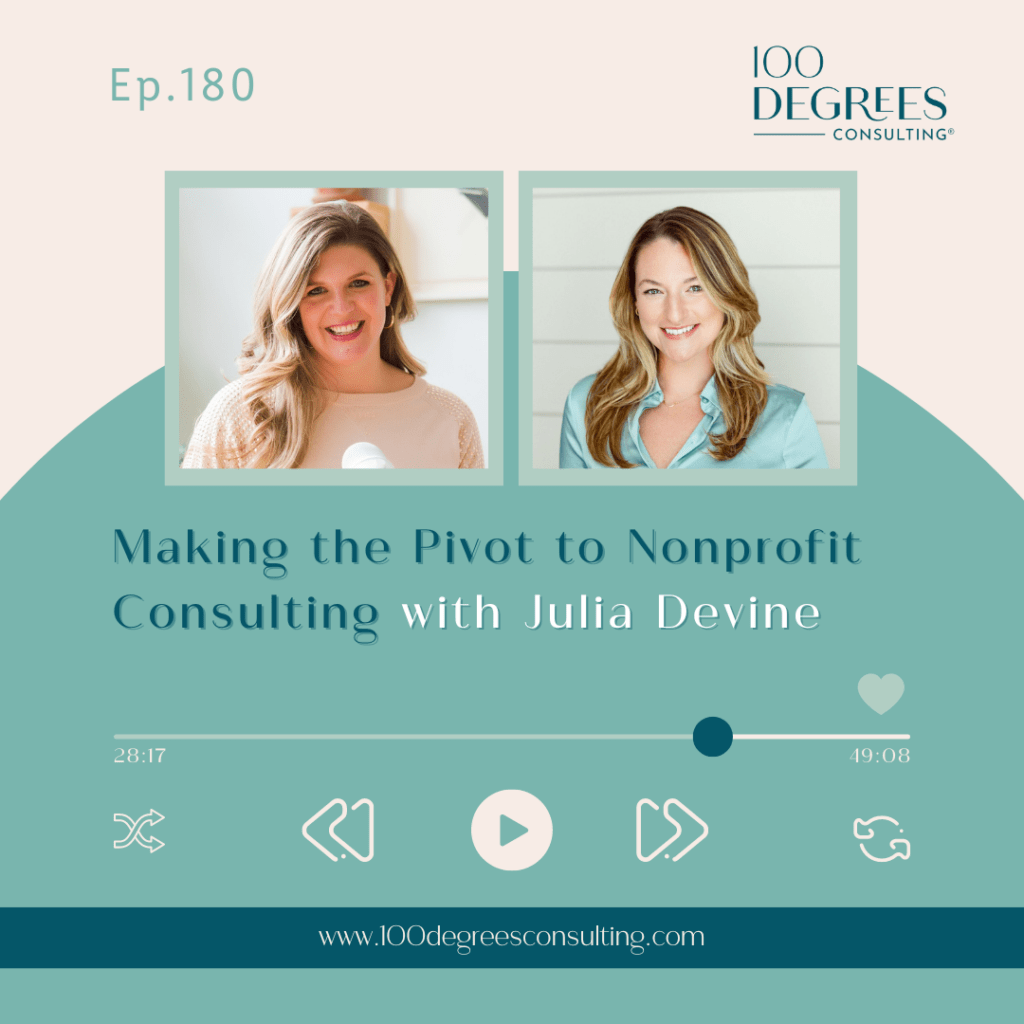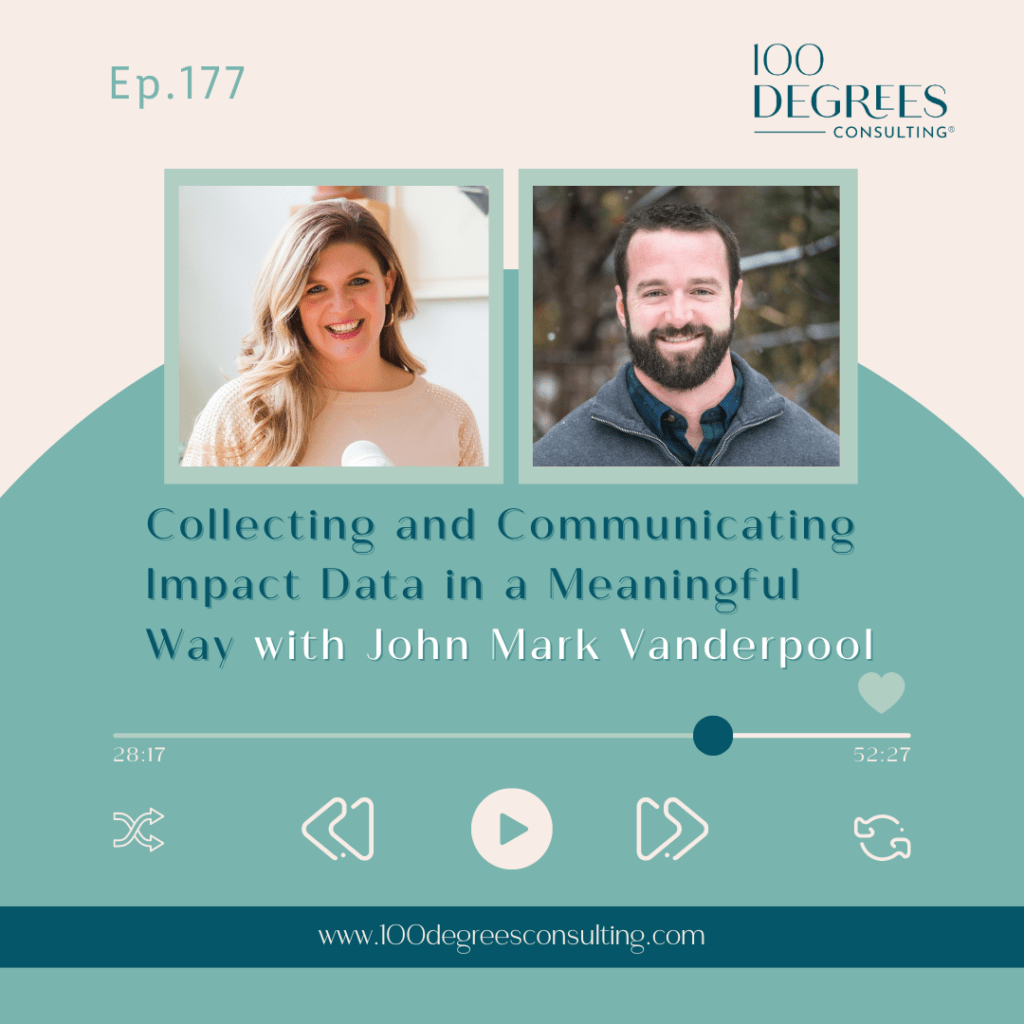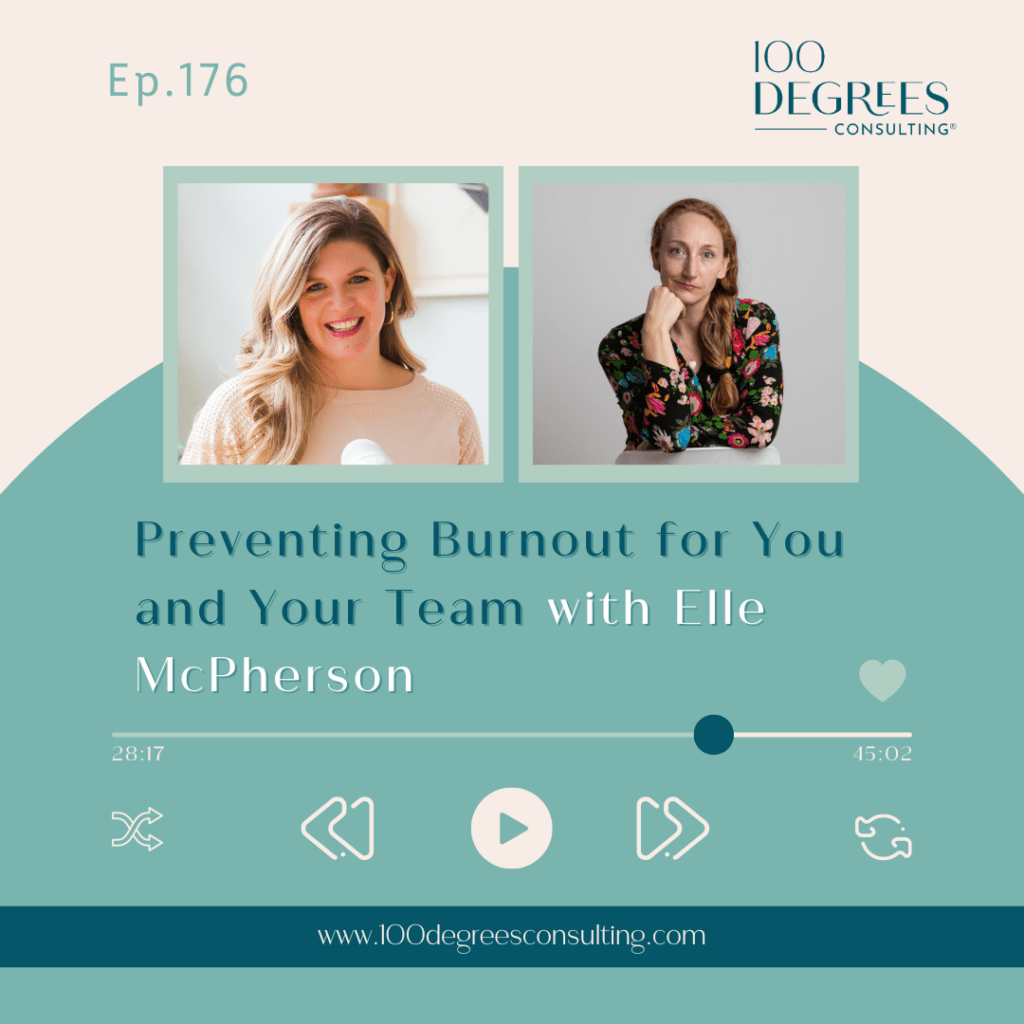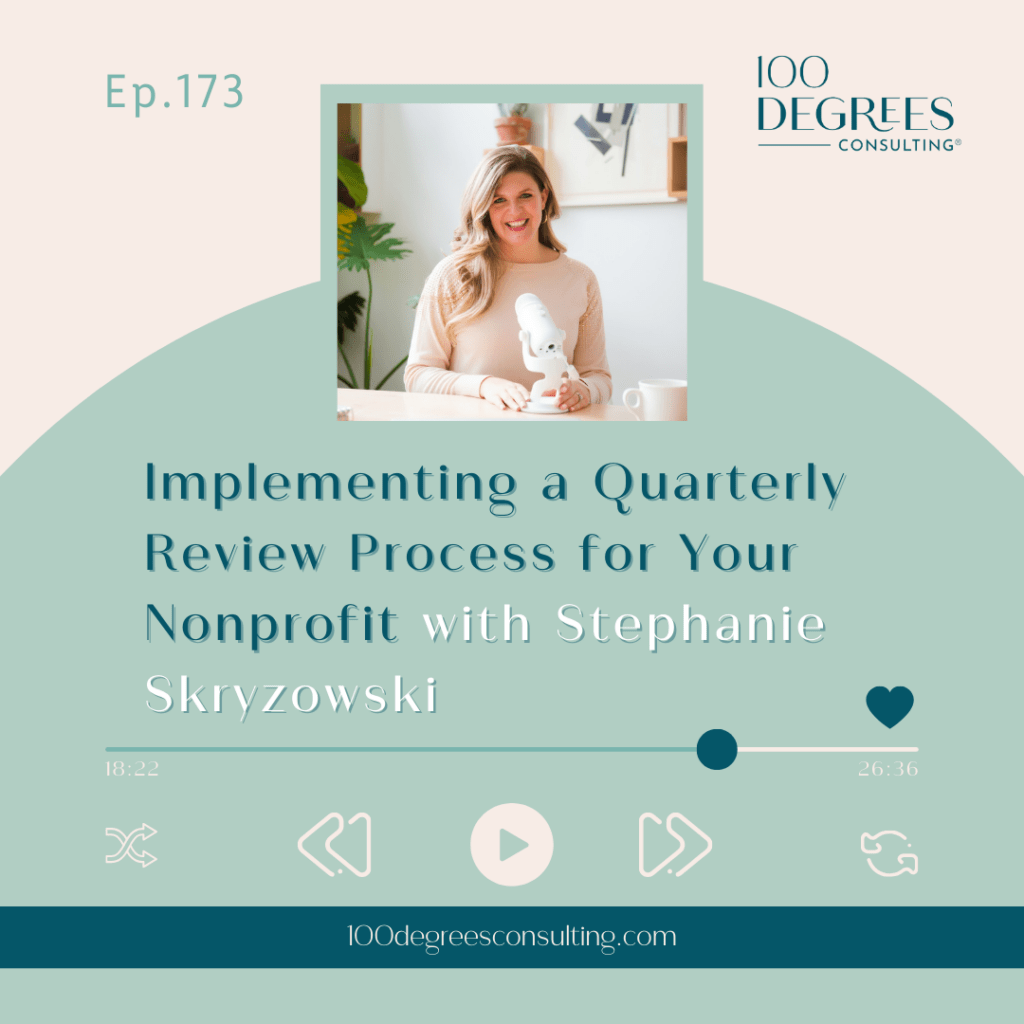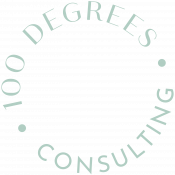Transcript Episode 130 – New Leader Success: The Nonprofit Leadership Dynamic on The Prosperous Nonprofit
Stephanie Skryzowski: [00:00:00] Welcome to the prosperous nonprofit, the podcast for leaders who are building financially sustainable and impactful nonprofits and changing the world. I’m Stephanie s Kowski, a chief financial Officer and founder, and c e o of 100 Degrees Consulting. My personal mission is to empower leaders to better understand their numbers, to grow their impact and their income.
On this show, we talk to people who are leading the nonprofit sector in new, innovative, disruptive, and entrepreneurial ways, creating organizations that fuel their lives, their hearts, and their communities. Let’s dive in.
Hello, welcome back to the prosperous nonprofit. It is me, Stephanie Kowski, and today I am really excited for the guests that I have on today I am talking to Ivan Gilreath, who is the C e O of the Boys and [00:01:00] Girls Clubs of Greater Scottsdale. And I’m also talking to Dina Terry, who’s the C F O for the same organization.
So we’ve got a C E O C F O Duo. Now Ivan’s background is that he’s been with Boys and Girls Clubs of Greater Scottsdale for I think he said almost three years. And before that he was at the Boys and Girls Clubs of the Midlands in Omaha, Nebraska. And prior to that he spent over 25 years at I N G and at Mutual of Omaha.
So he’s got a ton of corporate experience and then, Over a decade plus of experience in the nonprofit sector. Now, Dina, their C F o also has extensive experience in the nonprofit sector. She spent her entire career in a number of different nonprofit organizations, so between the two of them, they have seen it all.
We have such a good conversation today all about how the sector has changed and how they, as leaders in the nonprofit space have navigated those changes over the past few [00:02:00] years and how their organization came out on the other side of the pandemic. Now think about it. This is a boys and girls club, like their whole.
Mission, their whole organization is to do in-person activities with kids in their area. And so they talk a lot about what really helped them not only just survive but thrive over the last few years. We also talked about their relationship as a C E O C F O duo and the things that really help their relationship work really well and.
Ivan shared one thing that I think is just a game changer in terms of how he was able to bring Dina on first as controller and then promoted to C F O and how he was able to set her up for success. And now I swear, if every organization was this strategic and thoughtful, About the way that they bring leaders in.
I mean, we would have just superstar leadership teams in every nonprofit all over the country. So you need to listen and hear about this. ’cause I just think it’s so smart. [00:03:00] And in terms of what’s next for the nonprofit sector, I asked them that question and they’re really. Seeing nonprofits needing to elevate the professionalism and run the organization like a business.
And we talked about that a lot. How and why we should be running our nonprofits as a business. And I really think it can be a both and Right? We can run it like a business and we can still have the impact that we wanna have. Right. So this was such a good conversation. These are two people who I just really respect.
I’ve had the pleasure and the joy of working with both of them through my business 100 Degrees Consulting, but this was just an awesome conversation that I think will be really insightful for you and. Give you some really actionable tips on how to set up your organization for success. So without further ado, let’s go talk to Ivan and Dina.
Hey everybody. Welcome back to the [00:04:00] prosperous nonprofit. I am super excited to be here today with Ivan Gilreath and Dina Terry of the Boys and Girls Club of Greater Scottsdale, Ivan and Dino, welcome. Thank you. Good
Ivan Gilreath: morning. Thanks for
Stephanie Skryzowski: having us. Yeah. So first I would love for you each to tell us a little bit about your background and what you do at the Boys and Girls Club of Greater Scottsdale.
Ivan, why don’t you go first?
Ivan Gilreath: Alrighty. Um, well, I’ve been with the Boys and Girls Clubs of Greater Scottsdale for a little bit over two and a half years now. Prior to that, I was in Omaha, Nebraska, where I ran the Boys and Girls Clubs of the Midlands for exactly 10 years. Um, and moved down to, uh, Arizona to be closer to my two kids and my three grandsons.
And so, uh, we’ve got a family affair down here, uh, before that, going way back. Is, uh, I grew up in Omaha, Nebraska, and I was, I was a Boys [00:05:00] Club member, uh, way back in the early days of the boys club back in the, uh, in the sixties, if you will. So I grew up a, uh, a boys club member. And at 13, everybody in my house had to work because I had a, uh, I had a single parent, my mother who raised five kids.
I was the youngest one. And so we, uh, we all had to work. So at 13 I went away from the boys club and went and worked at McDonald’s and, and from there went on to get my, uh, undergraduate and graduate degree in business from the University of Nebraska, and then spent 30 years. In the for-profit sector, most of that being with Mutual of Omaha and Omaha.
So I was in the insurance industry and my last five years in the uh, for-profit sector was with a company called I N G, which is now Voya. Where I ran a division of that company in, uh, in Minneapolis, Minnesota. And, uh, when I was getting to the end of my [00:06:00] career on that side of business, I always knew I wanted to go back and work for an organization, uh, like Boys and Girls Club that did so much for me when I was young.
So it just so happens when I was reaching that. Point in my life where I said it feels like the right time to make a move. The person who was running the Boys and Girls Club in Omaha was retiring. So it was something that was a fateful moment where, uh, when I thought it was the right time, it happened to be the right time for the boys and girls clubs as well.
So I’ve been in the non-profit sector now for almost 13 years, after 30 years in the for-profit sector.
Stephanie Skryzowski: That’s amazing. So you’ve got, yeah, you have a very wide breadth of experience, which I’m definitely going to ask you about later, but thank you for sharing that. Dino, what about you? What has your background looked like?
What’s your journey looked like to get you to Boys and Girls clubs right now? I.
Deena Terry: So that’s interesting. Um, I’ve actually been in nonprofits or [00:07:00] governmental accounting my whole career. I had one job right out of high school while I was in high school, actually at a golf course, and that’s my only retail job because I knew right away that I wanted to work for something, you know, an organization with a higher purpose, if you will, or a mission.
And so I went right from. After college into the government service. I was a civil servant for about six years with the government. And then once that was done, I got out of civil service and went into nonprofits. My first job was with a foster care and adoption agency, so that was, uh, a lot of working with kids and helping them be placed in great environments, good homes, both foster and adoption homes.
And then I went to a community health center. That was a F Q H C, so that’s a federally qualified health center. We served the underserved population in our communities, medical, dental, vision, things like that. From there, I went to a mental health rehabilitation center, um, that [00:08:00] was a private organization, but we served people from all over the country.
Then we had a move. We decided to leave Michigan and come to Arizona to be closer to my in-laws, help them out. And I got really lucky. B G C S is right around the corner from my house, so I get to walk every day to work, and I’ve been here, November will be two years. It’s been a great experience and I kind of feel like every job I did before this job led me here.
Um, I love the mission. There are pieces of every job I had prior to this that factor into what I’m doing here, so it’s been a great experience and, and, uh, we’ve had a lot of fun.
Stephanie Skryzowski: Oh, that’s awesome. I love how our journey sort of like reveals itself to us as we go, and you don’t necessarily know where you’re gonna end up, but all of the pieces kind of make sense when you get there.
So I love that for you, Dina. That’s so cool. Well, you both have so much experience in the nonprofit sector, and I feel like especially in the last few years, we’ve [00:09:00] seen. So many changes in the sector between, um, you know, different funding priorities for our donors and changing technology and a remote workforce, and of course, like a global pandemic.
And so what changes have you each seen in the sector and sort of how have you, in your roles, whether it’s at B G C S or or otherwise, sort of dealt with those changes. Who wants to go first?
Ivan Gilreath: I’ll go first this time, Dina, I’ll let you go first next time. Okay. But, um, you know, as you know, we’re just coming out of the Global Pandemic and during the Global Pandemic.
Uh, a lot changed for us because we’re an organization that really values having as many kids as we can. In our programs. And so, uh, during the pandemic it was really weird because we couldn’t do that anymore. And so, uh, it, it really gave us a chance to focus on, uh, some safety [00:10:00] initiatives that, that are very important in our business as well.
So I believe we’ve come out of the pandemic a much safer environment for kids in terms of just staff to child ratios. Cleanliness, safety of our rooms, just spacing and how we interact with each other. So it really gave us a chance to, to step back and look at the safety initiatives while we dealt with smaller numbers.
Now that we’re back to our regular numbers again, I feel like we’re a much safer environment for kids because we were really forced to look and focus on those things. And I also believe now that we’ve become programmatically, Even a better organization because during the pandemic we had to figure out different ways to deliver our programming than we used to do before the pandemic.
So now in addition to being back together and doing programs together, we have more remote type [00:11:00] options and more things we can do with our kids. So I believe we’ve got a broader way of looking at things. And then of course, zoom has changed all of our life because, uh, it used to be everybody had to meet in person.
And we have nine locations here in Scottsdale. So sometimes it doesn’t make a lot of sense for us to meet in person because meeting in person takes a couple of hours out of the day of the people who are coming here to meet with us. So we still meet together ’cause it’s important to meet together and have that interaction directly.
But now, We don’t have to meet together and we can still be effective and we can make efficient use of everyone’s time. So I believe the pandemic, as bad as it was, it brought more efficiencies and more safety initiatives to the forefront of what we do.
Stephanie Skryzowski: That’s great. Thank you for sharing that. I think that’s really interesting to, you know, have been able to use this time that [00:12:00] was of course very difficult and challenging for so many, but to use it as a time to really strengthen your operation so that when you did come out the other side you’re, you know, a better organization, better able to serve the kids.
So I think that’s a really interesting take. So thank you for sharing that. Dina, what do you think, what have you seen, um, you know, what changes have you seen in the sector? What challenges have you faced and, you know, how have you sort of overcome those challenges? I.
Deena Terry: So I guess I wanna piggyback a little bit on the pandemic because I worked three different jobs during the pandemic, and that’s what I saw too, was, you know, we’re nonprofits and a lot of times people think that means that, you know, we don’t have to make a profit or we can’t make a profit.
But you know, when you’re faced with a pandemic like that and at the community health center, we couldn’t even see patients for a long time. So we lost a lot of revenue that way. At the mental health center, we couldn’t do events for the residents like we used to. And then here at the Boys and Girls Clubs, we [00:13:00] couldn’t have kids in the clubs.
I think it forced every, every one of the corporations I’ve worked for to rethink the quality of their programming and to find new and innovative ways to bring quality programming to whatever we were doing in that environment. So there’s that side of things. I, I think that services really have improved.
Another big thing I’ve seen is. Funding has changed for nonprofits. So I think we have to rethink how we look at our budgets and, and how we track our revenue sources. And I think that with the federal funding, there’s been an effect. It hasn’t been a negative effect on independent donors. Our private donors, I think that they’ve seen the plight we face and they’ve come to the table too.
So I think that that’s what’s come outta the pandemic. And I think the other challenges are just the, like we, like I’ve talked about earlier, the, the whole nonprofit, the illusion of nope, you can’t make a profit and things like that. That’s always been a challenge in the nonprofit sector.
Stephanie Skryzowski: So, That’s what I was just gonna say and kind of [00:14:00] come back to, I think that’s such an interesting point that I am always trying to stress.
It’s like just because we’re called nonprofits doesn’t mean that we should have $0 left over at the end of the year. We should not be spending every single dollar that comes in the door. And so, I think you’re right. The pandemic really. Hopefully, I don’t know, like shifted people’s thinking and it’s like, oh, okay.
Yeah, we probably shouldn’t budget to spend every less penny that we bring in this year because we need a cushion. We need a reserve, a rainy day fund, and it’s been really difficult for those organizations that did not have one throughout the pandemic. So, I wonder where organizations are at with this if we’re going to start to see a change in this sector overall or still not.
Like I don’t, I don’t know where that mindset is in the sector where this sort of like abundance versus scarcity mindset. Do you have any thoughts on that? I.
Deena Terry: Yeah, well, I think it is gonna change the way the financial people in these organizations [00:15:00] anyway look at revenue, and I think that it’s also gonna increase the applications for grants.
I think that grants have become a huge part of the nonprofit world.
Ivan Gilreath: Yeah, and I would add there, our umbrella organization, boys and Girls Club of America, uh, they’ve come out recently with, uh, a new set of membership requirements. So we’re a federated model, so we sort of act like a, a franchise. So we have our own board of directors, but we still have to follow certain membership requirements of Boys and Girls Club of America.
And one of the new membership requirements is that all clubs and they’ve got. Over a thousand organizations like us in the movement, all clubs must have a cash reserve on hand, and that previously wasn’t a requirement. Now the recommended amount of the cash reserve is three months of cash on hand. So your, your average expenses for a month, times three.
[00:16:00] So that’s the average. So, you know, you’re starting to see, and you can’t get a cash reserve unless you get in more revenue. Then, then you have expenses. And so, uh, but, but that is a fine line, Stephanie. It’s a fine line because the, the services that we provide, Our donors expect us to spend our money on our kids.They’re, they’re giving to us because they wanna make sure the programs and the services that we told them we were going to do for the kids. We do, in fact do. So it’s a fine line there, but you obviously have to have some surplus to get your cash reserves to where they need to be. So you are a solid.
Financially secure organization. And so I believe more nonprofits are looking at it that way because in years past, nonprofits will really have no cash on hand, and we all know that’s a very dangerous model to have.
Stephanie Skryzowski: [00:17:00] Absolutely. One of the things that I think is so important to building that cash reserve is having like a diverse revenue portfolio, which I think you all have, right?
Because you’ve got your program service revenue from your, your programs, but then there’s also grants and individual donations and things like that. But I’ve seen lots of organizations, and maybe you have as well, where. They’re getting pretty much all of their revenue from one type of source. Maybe it’s just grants.
And those grants are all like pretty restricted. And so they’re running into, you know, into the issue where, okay, well we don’t have a lot of unrestricted dollars to pay for our finance team salaries or whatever. So I think like revenue diversity is super important as well to help build that cash reserve.
Does Boys and Girls Clubs of America, do they have any sort of policies or guidelines on revenue diversity?
Ivan Gilreath: I don’t know that I’ve seen any of those, but all of the organizations around the country know that our push should be [00:18:00] for operating dollars. So operating dollars are dollars that you can use, uh, in any capacity to run the business because 80% of our budget is people.
So we have to have enough money to pay our people. So if we have too many dollars tied up in restricted request, uh, it can really get you upside down. And we had that problem a few years ago and we have consciously tried to push toward more operating dollars, but the clubs don’t have a, a policy on that.
But we all understand the importance of asking donors for operating dollars versus the restricted dollars.
Stephanie Skryzowski: Yeah, yeah. Dina, what have you seen in terms of like, you know, that connection between having a diverse revenue portfolio, having a cash reserve, or any organizations that you’ve seen that maybe have not had or diverse revenue portfolio and like where they’ve ended
Deena Terry: up with that?
Yeah, so the problem with not having a diversified portfolio is if, if you have one source or [00:19:00] one or two sources and that dries up, you’re really in trouble. So, We now have so much more visibility into our program revenue, so we can see exactly what we’re charging, exactly what we should be collecting, exactly what’s sitting there in a non-payment, you know, pot if you will.
And that has been wonderful for us because I think I, and I know actually that that program revenue is. Kind of becoming the bigger source of our revenue than our donations. I mean, we’re, we’re getting there. And B G C A has a recommended or a suggested amount, percentage of what your contribution should be to your total revenue.
And I think we’re over that and contributions, but the program revenue is gonna, I think, take that over. So I feel really, really diversified in this job. So I think we’re on the right path.
Stephanie Skryzowski: That’s awesome. And I love the fact that you have that data at your fingertips. I mean, I’m always talking to like anyone and everyone who will listen.
Like it’s so important to know your [00:20:00] numbers so that you can make really smart decisions. So one of my questions was how have you used technology to further your fundraising, further your strategic decision making? And I think you just like partially answered that, but it sounds like having this sort of data.
Forward or data-driven process can also support your revenue growth. So, I don’t know. Talk more about that. Talk more about data technology and how has that really helped you both to make really smart decisions for the organization?
Deena Terry: The information I have at hand, we can track ar at any given moment. I mean, it’s, it’s at the touch of a button and it’s.
It’s live, it’s real time. So that allows us, you know, every day we can be going after collections, we can be making sure that, you know, we’re not getting too far off the path there of what we have and, and what we’re supposed to get. So that has been a phenomenal tool as far as generating, not generating revenue, but making sure we’re collecting our revenue.
Ivan Gilreath: Yeah, and Dina and I are both [00:21:00] structured, data-driven people and for years, Sort of what you would hear about folks who worked with nonprofits were, you know, how they kind of just ran by the, the seat of their pants and, and didn’t really run it like a business. And we’re both firm believers that this is a business.
It’s a significant business. And what really helps me is my 30 years of actually running a business, coming in here, realizing what we do and how we do it, but also we need to look at this from the standpoint of it being a business. It needs to be a profitable business. It needs to be a successful business, and it needs to be an outcomes driven business.
And so for us, I. Data is key. And we weren’t doing a good job of billing and collecting before we got this, my Club Hub product in here. And it’s really changed our world, if you will. And then even on development, even though [00:22:00] development is pretty much a, a meet with people and build relationships kind of thing, you can’t effectively do that without good data.
You need good data on who your donors are. How they’ve historically given who your targets are in terms of donors and how they’ve historically given to other organizations. So you really can’t do any aspect of this job correctly without good data.
Stephanie Skryzowski: So true. Yeah. As a finance numbers spreadsheet person, you know, I could not agree more.
This series is sponsored by Blackbaud, the essential software provider for the organizations and people who change the world. Blackbaud has been working with finance professionals at nonprofit and social good organizations for almost 40 years with its Blackbaud Financial Edge, N X T Fund, accounting software expertise and services.
You can streamline your financial operations, strengthen your accountability, and [00:23:00] make data-driven decisions to increase your impact. To learn more, visit blackbaud.com.
Ivan, you as the c e o Dina, you as the C F O. You both have the same mindset when it comes to data, which is fantastic. But I’d love to talk a little bit more about what your sort of C E O C F O working relationship looks like. How do you really compliment each other’s work? Are there any areas where maybe you butt heads.
Not in like, you know, not in an aggressive way, but like, you have differences of opinion, we’ll say. Um, but what does that working relationship look like? Because I think you guys have a very good sort of balance going on that C E O C F O worked together. So I’d love to hear a little bit more about that.
Ivan Gilreath: Well, as you know, Stephanie, um, Dina and I. Started working together. Maybe not in the, uh, the best of circumstances. We here were without A A C F O here. You know, the, the C F O we [00:24:00] had had departed and you really couldn’t find, I. The right candidate for that particular role for me, and that was around the time Dina had moved down here.
And we had your firm sort of doing the C F O responsibilities for us at that time. And at that time we needed to stabilize our finance infrastructure. And Dina just moved to town and so we brought her in as a controller to help with some of the day-to-day finances, realize that she had a wealth of experience, but really didn’t know much about the club.
So we brought her in, uh, as a controller while we kept a hundred degrees consulting there to sort of help fractionally with some of the c f o duties. So by having that kind of relationship where right away we didn’t put the full duties of c f O on Dina and relied on your firm and allowed her to learn the business, learn me, me, learn her, it really gave us a chance to develop a [00:25:00] relationship.
From not as much of a pressure cooker scenario. And so we were able to learn what each other likes and how we can more effectively work together. And we sort of built it to the point where Dina was taking on all of the c f O responsibilities. Uh, it got to a point where we no longer needed your firm.
Thank you so much for all you did to get us there. But we had a chance to grow the relationship without having it in the pressure cooker environment from day one. So we learned how to work with each other, and that sort of carried on to, now that she’s C F O, I know how she looks at things. She knows what I expect to see, great relationship with our chair of the finance committee.
And so it really allowed us to grow the relationship organically and the right way to where. We learned what makes each other tick.
Stephanie Skryzowski: I love that. What are your thoughts, Dina? [00:26:00]
Deena Terry: So, um, first thing that comes to my mind is Stephanie, you know, during the interview process when I was interviewing, one of the, one of the comments that, uh, I made was, I’m a friendly introvert.
’cause we were talking about a finance person versus, and I think that’s one thing. I think, uh, I would say that Ivan’s much more extroverted than me, but that works for us. We compliment each other that way ’cause I’m the introvert. But other than that, I think that Ivan and I have very similar ways of thinking.
We’re in agreement on a lot of things. And one example is it’s a nonprofit. There’s a wonderful mission involved, but it’s also a business. And one of the things we’ve done is the nine locations that we talked about. We’re having the directors of each location run their own budget like a business, so, so we’re very like-minded in that.
So I think we have the same goals and I think we’re working really well towards accomplishing
Stephanie Skryzowski: our goals. Yeah, I think that’s so smart what you said, Ivan, about not having thrown Dina into this like [00:27:00] firefighter role where it’s like, come in, you gotta fix all these things, good luck. And just like letting her fend for herself because that’s such a recipe for like instant burnout and just.
Not being happy in the role and not really being effective. And so I think that was so thoughtful and so strategic, and I think it’s so important when organizations are thinking about bringing a C F O on or bringing another leader on to really ask themselves, okay, do we have the. Capacity to set them up for success.
And so you absolutely did that when you hired Dina by, you know, being able to ease her in and having additional support that you’re able to provide so she’s not just coming in and, and having to fight all the fires. ’cause that’s not fun for anyone. So, I think that was really smart to have her be able to be set up for success.
And I remember Dina when like we were officially like our team was sort of rolling out. I’m like, or actually I think when we were in our initial conversations, maybe even before you got the job, like [00:28:00] my goal is to have everything wrapped up like in a nice little box wrapped up with a bow. And to be able to like hand that off to you.
I think that’s great. Dina, I think it’s such a good point that you are both really data driven and you think very similarly yet you also have complimentary sort of assets because Yeah, I, I have often seen, I’ve seen several organizations that just like churn through CFOs because the C F O and the C E O just think too differently and are not on the same page when it comes to some of those essential things.
So that’s another reason I want to have you both on, ’cause I think. You know, your relationship is a great example for other organizations that are thinking about hiring A C F O.
Ivan Gilreath: Yeah, and you know, Stephanie, we were one of those organizations, we’ve churned through some CFOs prior to, to me being here, and I think it’s because we bring them in.
They didn’t know much about the organization, didn’t know, and we said, Fix [00:29:00] it. And they’re like, I don’t even know how to spell it yet, and you’re telling me how to fix it. And so, you know, it just wasn’t a recipe for success. So that’s why having organizations like yours that can help bridge a situation to where we can really grow, uh, the people we bring in, and also grow our relationship a little bit different way than normally, uh, organizations have.
I.
Deena Terry: Absolutely. Yeah. Yeah. And that gave me a chance. I, I really enjoyed working with you and your firm because that gave me a chance to kind of, I know that we were both kind of thrown into a situation in one fiscal year where we were scrambling, but we were in it together. So that was helpful for me to kind of learn the ropes with you, with your firm, and then that allowed me the chance to get to know Ivan better and to grow on this side in the office.
So that was a wonderful opportunity, and I think I’m better for it.
Stephanie Skryzowski: Yeah, absolutely. I agree. It’s just a really smart process, I think. And [00:30:00] you know, given that now you are the C F O, you’re coming up on your two year anniversary, like clearly the process worked and so I think it’s just a lesson for anybody listening as you’re thinking of bringing in a leader to the organization, how can you do it, um, in a really thoughtful ways?
You’re not throwing them into the fire and giving them a list of 50 things to fix and say, good luck. Yes. Yes. Yeah. So what do you see, like if we had a little crystal ball looking into the future of the nonprofit sector, what do you see? It doesn’t have to be anything specific. It could be related to finances or programming or funders or whatever.
Are there any sort of trends that you’re seeing or predictions that you have? Um, what’s coming down the pike for us as nonprofit leaders?
Ivan Gilreath: Well, I, I believe, and I, I think this trend has kind of been out there for a while. Your funders, in particular, your, your foundations, uh, they’re really raising the bar on what they expect from nonprofits.
It, it used to be that [00:31:00] you just go and, and ask for funding and, and you may or may not get it, but now they’re challenging you more to know what you’re gonna do strategically. You know what you’re gonna do innovatively and what you’re gonna do in terms of reporting and outcomes. And so I believe in a good way, the bar continues to be raised on what is expected of nonprofits.
And I believe the leadership and the nonprofit community, the requirements there and the talent that’s being hired in the nonprofits is, is really at that level where, Just because you’re a nonprofit doesn’t mean you should be sloppy. You should have your T’s crossed and your i’s dotted. And so I believe that challenge making us better is gonna make what we offer better for our members and for our families in the future because we’re holding ourselves to a higher standard, which means that the standards will be higher for what we [00:32:00] provide our members and their
Stephanie Skryzowski: families.
I love that. Yeah, like elevating the level of professionalism in the sector will result in, you know, an elevation of the programs and the impact that we’re able to have. I love that. What do you think, Dina? I.
Deena Terry: I totally agree with that because I have seen in my career, it used to be that private donors, grantors, they would just give you the money without very many restrictions at all.
They wouldn’t ask for much back. But now you have programming requirements. You have reporting requirements, and it’s not just the grants, it’s the donors as well. So there’s that extra, you have to be a good steward and you have to show that you’re being a good steward, number one. Number two, I think Ivan’s, right?
I think nonprofits, in the old days when I first started, you know, a lot of nonprofits were kind of run like a mom and pop, and that does not exist anymore. If it does, it’s, it’s very rare. And so for me, in my career, you know, I, I never [00:33:00] wanted to cross that line. I always wanted to stay in the nonprofit sector.
I, like I said, I like a mission. I like being part of a team, but, In my day, it wasn’t possible. Once you were in a nonprofit, you couldn’t get to that retail or profit side because they didn’t think you had the skills to succeed and to run that type of business. I think that’s becoming less and less the case and people that are now just getting into finance accounting, I think they can do either one.
They want, because nonprofits are held to the same standards as
Stephanie Skryzowski: profits these days. And I think that just places such an emphasis on technology and systems and, you know, we need to be able to spend money on these things so that we can elevate the level of the work and the analysis that we’re doing. And yeah, I just think that’s so, so important to be able to have those systems sort of as the foundation of the work that you’re doing so you actually can, you know, use that data, make strategic decisions.
Things like that. So yeah. Great insights. Thank you. Ivan, were you [00:34:00] gonna say something else? No, I
Ivan Gilreath: was just thinking about, not, not here in Scottsdale, but when I was in Omaha and one time I, uh, I had a meeting with one of my long time, uh, they had been with the clubs in Omaha for years, and they came into me and they said, We’re running this like a business, and I was like, yes, we are, and we’re gonna continue to run this like a business.
I’m like, it is a business. And they were dead serious because they, they had never had any structure in terms of, of how to handle expenses and revenue and, and programming. And they were like, you’re running this like a business. I said, well, Yes, I am a businessman and that’s the way we’re gonna run it, but never lose sight of why we’re here,
Deena Terry: right?
Yes. And at the end of the day, being a good businessman also makes you a good steward because you’re not just taking that money for granted and throwing it at whatever you’re thinking about. Where am I putting this money? How much am I [00:35:00] spending? So that’s all good in the end.
Ivan Gilreath: I’ll give you another example if I could.
Stephanie and Dina knows this just to, you know, to, to not overemphasize the business part of it, but we deal with a lot of kids who can’t afford to come. And so program revenue is one of the things that we need that we thrive on, but Dina and I are in sync on if somebody can’t pay, if somebody can’t pay.
They can justify to us they can’t pay. It just can’t be somebody telling us somebody can’t pay. So if they can justify that they can’t afford to pay, we will let them in the club free. Because that’s a good business decision for us, and that’s a good decision for our mission. We will never turn a kid away because they can’t pay.
So we’re not business people to a fault where we’re like, if you can’t pay, you can’t come [00:36:00] because we’re here. To take care of the kids who need us most. So being a good businessman is deciding sometimes you have to do whatever you can to make sure you serve the population you’re here to serve.
Stephanie Skryzowski: It’s like being, you know, running a business isn’t all about money.
It’s, yeah, the money is part of it, but it’s also the impact. And so I think that it’s a both and situation rather than an either or situation. And I love that that’s the way that you run your organization. Yeah, I think that’s huge. So my last question as we are wrapping up, and I would love to hear from both of you.
What does a prosperous nonprofit look like to you?
Deena Terry: So to me, a prosperous nonprofit is one, as we discussed, that’s not necessarily doing a balanced zero budget, you know, revenue expenses, but one that’s accomplishing its mission successfully. And that means that the people that you’re trying to help [00:37:00] are, are the services you’re providing are quality services that people are getting the most they can out of them.
Also keeping the staff happy. You know, it’s always good to have a staff who loves what they’re doing and is out there feeling like they’re appreciated. And if you have both of those, I think you have a successful nonprofit. And
Ivan Gilreath: from my standpoint, uh, all of what Dina said, and I just think a successful nonprofit needs to be strategic.
Uh, we’re in the third year of a three year strategic plan and we’ll be working on a, a new three year strategic plan in the spring. So I think you need to be strategic. You need to kind of have a roadmap of where you want to go. Uh, you always have to be forward thinking, you know, you just can’t sit on your laurels.
You gotta think about where you want to be in the future. And then finally, based on everything we’ve been talking about in this call, you gotta be well run, gotta be well run and well managed. So, uh, in addition [00:38:00] to what Dina said, those are my additional thoughts.
Stephanie Skryzowski: Awesome. Thank you so much. I wholeheartedly agree with everything that you just said.
So Ivan Dina, thank you so much for joining me. This has been such a great conversation and it was just nice to catch up with you both. So thank you so much. Thanks Stephanie. It was
Deena Terry: fun.
Ivan Gilreath: Alright, go Patriots. You got a good running back yesterday.
Stephanie Skryzowski: Yes, that’s right. Oh, I miss our N F L talks every Monday.
Hey everybody. Thank you so much for listening to this week’s episode, sponsored by Blackbaud. As always, you can get all of our show notes, all of the links we mentioned over at 100 degrees consulting.com, and I want to mention something extra special. Over there, you will find the link to our brand new white paper, the Guide to Hiring a Modern C F O for your nonprofit.
So this is a white paper that I wrote in partnership with Blackbaud, and [00:39:00] you will learn what it means to be A C F O who can help drive a nonprofit in today’s climate. What you should consider when hiring a modern C f O and red flags to look for when evaluating your next C F O. So head on over to 100 degrees consulting.com.
Grab the show notes for this episode and we will point you in the direction of this brand new white paper, your guide to hiring a modern C f O for your nonprofit. Thanks as always for listening, my friends, and we will see you next time.


